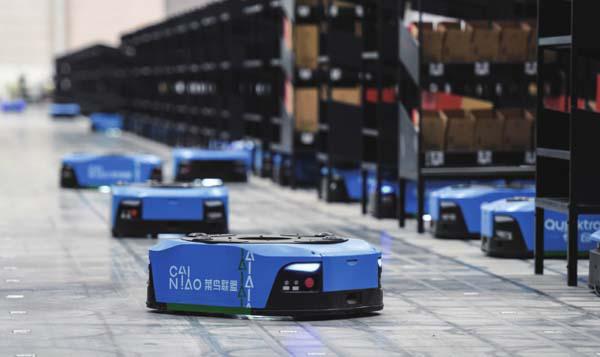A Shared Future in Cyberspace

A visitor experiences VR technology at the Light of the Internet Exposition which took place on November 6. The expo was part of the fi fth World Internet Conference held in Wuzhen, east Chinas Zhejiang Province, on November 7-9.
President Xi Jinping sent a congratulatory letter, saying “We should speed up the development of the digital economy and promote the global Internet governance system to advance in a just and more reasonable way, so as to inject new impetus to the world economy.”
AI Theme Park
Chinas fi rst artifi cial intelligence (AI) theme park opened to the public in early November, after a 10-month renovation project of a municipal park in northern Beijing. Driverless shuttle buses, smart lamp posts that can record exercise data, and intelligent speakers that can respond to human instructions have been installed in Haidian Park, which covers 34 hectares near the citys Fourth Ring Road.
The local government in Haidian and Internet company Baidu signed an agreement in January to jointly explore “smart city” building. Haidian Park, which received 1.2 million tourists last year, was chosen to run the pilot program.
A total of 10 government departments and companies participated in the renovation of the park over the past 10 months, said Che Jianguo from the parks administration offi ce. In recent years, Chinese hi-tech companies have established themselves in the AI industry, while Central Government also stressed in October that it would boost the development of a new generation of artifi cial intelligence.
Fresh Victory
For millions of Chinese e-sports fans, this year marks a new apex of excitement after the countrys stellar performance over the weekend. Chinese e-sports club, Invictus Gaming, defeated the European club Fnatic, 3-0, to claim the championship at the 2018 League of Legends World Championship in Incheon, South Korea, on November 3. It was the fi rst time that a club from the Chinese mainland won the title in the world championships eight-year history.
The long-awaited victory led to a fl urry of activity on social media with billions of views on Weibo. At least a dozen of the top 50 trending topics on Weibo was about Chinas victory. “Winning the world championship is unreal for me and I never thought it could become a reality,”said Yu Wenbo, known as Jackeylove on the Internet, an e-sports player with club IG.
Yu was not the only one bowled over as Chinas e-sports experts surprised the nation multiple times this year. Team China participated in three of the six e-sports events at the 2018 Asian Games in August, which included the game as a demonstration sport for the fi rst time in the Asiads history, China pocketed two gold medals and a silver at the games.
The victories and the popularity of e-sports are the inevitable results of a dramatically growing market in China.
Undersea Subway Tunnel
China announced that construction has fi nished on its deepest undersea subway tunnel on the mainland in a statement released on November 6. The cross-sea subway tunnel, running 8.1 km with 3.49 km of the line undersea, links east and west Qingdao, a coastal city in east Chinas Shandong Province, said the China Railway No.3 Engineering Group.
It is the deepest undersea subway tunnel on the Chinese mainland, with one section rooted 88 meters below the sea. Construction of the tunnel started in September 2015, according to local media. It is part of a 59.97-km subway line that links downtown Qingdao with Huangdao District, signifi cantly cutting the travel time from one side of the city to the other.
Green Waterway
A total of 1,361 illegal wharfs along the main channel of the Yangtze River have been demolished or renovated, according to the National Development and Reform Commission. Increasing human activity has damaged the ecological environment along the Yangtze River, as well as endangering rare species and biological resources over the years, said Xiong Qiquan from the commission.
Xiong said 1,254 wharfs had been torn down to make room for greenbelt areas, and the remain-ing 107 have been upgraded. Crackdowns on illegal sand mining, chemical pollution, and sewage disposal have been carried out to restore the river environment and protect the water source. Nearly 900 nature reserves had been established along the main channel of the Yangtze as of the end of 2017.
Energy Structure
China has sped up efforts to move from a coal-oriented structure to a cleaner and more diversifi ed energyproduction, according to a report released by the National Bureau of Statistics. Natural gas output reached 148 billion cubic meters, and primary electricity came to 1.8 trillion kw hours in 2017, data showed.
The share of clean energy production saw continuous growth. Natural gas made up 5.4 percent of the total energy production, while electricity and other clean energy jumped to 17.4 percent last year, the highest since 1978, according to the report. Chinas net energy imports also followed an optimized trend last year with the import of raw coal down 1.2 percent and natural gas up 18.4 percent when compared with that of fi ve years ago.
Welcoming the Winter
Children at a kindergarten in Langfang City, north Chinas Hebei Province, learn to make dumplings on November 6. An activity welcoming Start of Winter, the 19th solar term of the year, is held to help children learn traditional customs.
Panda Program
A public welfare program aiming to share stories of panda-human relationships has been unveiled to the public. The project aims to present Chinas tremendous ecological con- servation achievements in protecting endangered species.
China Network Televisions iPanda channel and the Chengdu Research Base of Giant Panda Breeding jointly launched the Worldwide Giant Panda Keeper Volunteer Program in order to enable the public, both domestic and international, to better understand giant panda breeding.
Twenty-seven young people from around the world will be selected to come to Chengdu, capital of southwest Chinas Sichuan Province and known as “home of the panda”, to undergo closed-door, professional training and witness the breeding of giant pandas. A number of other events have been hosted by the base in recent years to present scientifi c research on giant pandas, calling on the public to lead an ecofriendly lifestyle.
Climate Observatories
China will speed up establishing national climate observatories, an offi cial from China Meteorological Administration (CMA) said on November 6. Climate change has become a worldwide concern and to address the problem it is necessary to conduct comprehensive observations of the climate system, Zhang Zuqiang, Director of the emergency relief and public service department of CMA, said at a press conference. The national climate observa- tories will function as integrated meteorological stations to carry out long-term, consecutive and all-around monitoring of the multilayered climate systems and the interactions among different layers.
The observatories will also serve as a platform for scientifi c research and talent cultivation. They will also be open to administrations at home and abroad, Zhang added.
During the implementation of the 13th Five-Year Plan in China, which extends from 2016 to 2020, CMA will establish national climate observatories in 16 critical areas in the climate systems which are sensitive to interactions among distinctive layers and exchanges of mass and energy, Zhang said.
In 2007, f vie meteorological observation stations in the Inner Mongolia Autonomous Region and provinces of Anhui, Guangdong, Yunnan, and Gansu were chosen as the pilot areas for establishing the climate observatories.
Lights On
Staff members of a paper lantern factory in Jianou City, southeast Chinas Fujian Province, discuss the design of their products on November 4. Paper lanterns produced by local enterprises and workshops are now exported to markets in Europe, North America and Southeast Asia.
New Tech Board
The Chinese security watchdog will speed up work on rules for a science and technology innovation board to be launched in Shanghai, it said on November 5.
China announced its decision to launch a science and technology innovation board at the Shanghai Stock Exchange (SSE) and experiment with a registration system for listed companies.
The China Securities Regulatory Commission (CSRC) said that the commission along with the SSE will step up efforts to bring the mechanisms and rules to completion, including drawing on international experience and improving information disclosure.
There will be differentiated policies on the profi tability and ownership structure to help innovative companies go public, according to the CSRC.
The CSRC described the new board as a major reform to drive innovation, promote high-quality development and support Shanghai in cementing its position as an international fi nancial center and a hub of science and innovation.
Green Economic Belt
On November 7, China unveiled a plan to promote the construction of the Huaihe River Green Economic Belt in a bid to foster regional economic and ecological development.
The plan, issued by the National Development and Reform Commission, maps out the strategic position and targets of the economic belt.
It will be developed as a pilot area for ecological civilization, distinctive industries, a new type of urbanization and central and eastern regional cooperation, the plan said.
By 2035, the plan aims to transform the economic belt into a dynamic area with an improved ecological environment, boosting the local economy and narrowing the gap between urban and rural areas.
Covering 243,000 square km, the Huaihe River Green Economic Belt refers to surrounding areas along the river in central and east China.
By the end of 2017, the gross domestic product of the area reached 6.75 trillion yuan ($976 billion), with 146 million residents.
Robots in Place
Smart devices in the Future Park of Cainiao, the Alibaba Groups logistics arm, carry goods on November 8. Located in Wuxi, Jiangsu Province, the park has become Chinas largest robot intelligent warehouse with nearly 700 robots for increasing effi ciency and cutting management costs.

Power Line Development
The construction of an ultra-high voltage power transmission line to deliver clean energy began on November 7.
The 1,587-km-long transmission line starts in Hainan Tibetan Autonomous Prefecture in northwest Chinas Qinghai Province and ends in Zhumadian City in central Chinas Henan Province, connecting Qinghai, Gansu, Shaanxi and Henan provinces.
According to the plan, the transmission line, with a capacity of 8 million kilowatts, will begin operation in 2020 and deliver electricity generated from solar power, wind and water from Qinghai to central China.
With an investment of 22.6 billion yuan ($3.26 billion), the transmission line is estimated to deliver electricity of 40 billion kilowatt-hours each year, which will help replace 18 million tons of raw coal and reduce 14,000 tons of dust emissions, along with 90,000 tons of sulfur dioxide emissions and 29.6 million tons of carbon dioxide emissions.
Services Import Prospects
Chinas cumulative services imports are expected to exceed $2.5 trillion in the next fi ve years, a Ministry of Commerce report showed on November 6.
The countrys services imports will account for more than 10 percent of global services imports, contributing over 20 percent of total global growth in the next fi ve years, according to the Report on China Services Imports.
Over the next f vie years, Chinas imports of travel services are expected to exceed $1.4 trillion, while Chinese tourists will make an estimated total of 700 million outbound trips as the countrys consumption power grows, the report said.
During this period, China will see over $700 billion of cumulative imports in emerging services, including charges for the use of intellectual property, telecommunications, computer and information services, fi nancial services, and cultural and recreational services.
China has seen rapid growth in imports of services since it joined the World Trade Organization. Its services imports surged to $467.6 billion in 2017 from $39.3 billion in 2001, with its global share increasing to 9 percent from 2.6 percent, offi cial data showed.
In terms of the global travel industry, Chinas outbound travel consumption has contributed 16.7 percent of the added value and created about a quarter of jobs in recent years, according to the report.
Smart Cooking
A worker operates a cooking machine in an automated restaurant in Beijing on November 7. The restaurant is equipped with seven cooking machines programmed to prepare popular Chinese dishes in minutes without the need for human chefs.
AI Expansion
Chinas technology companies have gradually transformed the countrys fi nancial sector by incorporating artifi cial intelligence (AI) into their services. Many top IT companies including Alibaba, Tencent and JD.com have protracted their businesses into the fi nancial sector, establishing platforms after obtaining fi nancial licenses.
In its latest report on Chinas fi nancial stability, the Peoples Bank of China (PBC) labeled these IT giants engaged in fi nancial business as fi nancial holding companies.
Their presence has stimulated the proliferation of FinTech and relevant applications in China, especially in terms of investment advisory services, risk management, and customer services. The utilization of AI technologies in fi nance also contributed to effi ciency improvements and cost reductions for fi nancial institutions.
Along with the rapid use of fi nancial technologies, almost 1,900 FinTech startups established in China over the past three years, according to a FinTech database developed by the Tsinghua University PBC School of Finance.
Meanwhile, the risks brought by utilizing AI technologies in fi nance should not be neglected, said the PBC, which unveiled a series of regulations to supervise the emerging services backed by AI.
According to the central bank, exaggerated advertisements are prohibited when utilizing AI, and fi nancial institutions should provide clear transaction procedures and offer manual intervention when algorithm defects appear.
Resources to Profits
A technician examines a wind power transmission system in Yulin, Shaanxi Province, on November 6. After it is completed, the system will supply electric power to six cities in the province and help translate the local resource advantages into economic competitiveness.
Soaring High
Chinas general aviation industry has maintained rapid growth in recent years, and the number of general aircraft will increase to over 20,000 with fl ying hours totaling 6 million a year by 2035, according to a white paper released on November 6.
In 2017, China had 2,984 general aircraft. The annual fl ying hours of general aircraft increased from 370,000 in 2010 to 840,000 in 2017.
The white paper, released by the Aviation Industry Corp. of China Ltd., said that the Chinese general aviation industry has seen signifi cant changes in business structures as short-distance transportation, low-altitude airspace tourism and business trips increased rapidly, while industrial and agricultural use decreased.
The industry will enter a phase of rapid growth in the next fi ve to 10 years as China continues to push forward the reform to delegate powers, strengthen compliance oversight and improve government services.
China is set to boost development of its general aviation industry to create a market worth more than 1 trillion yuan ($153.8 billion) by 2020.
The country will build new general aviation airports, bringing the total number to more than 500 by 2020, according to a guideline issued by the State Council, Chinas cabinet.
It also plans to increase the number of general aircraft, including helicopters and private jets, to more than 5,000 by 2020.

